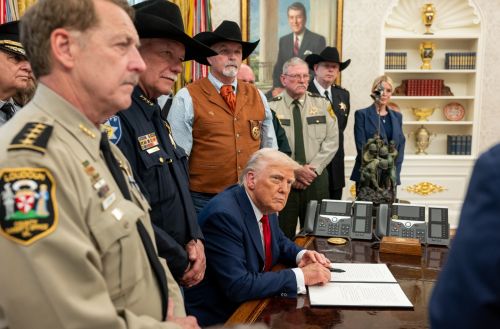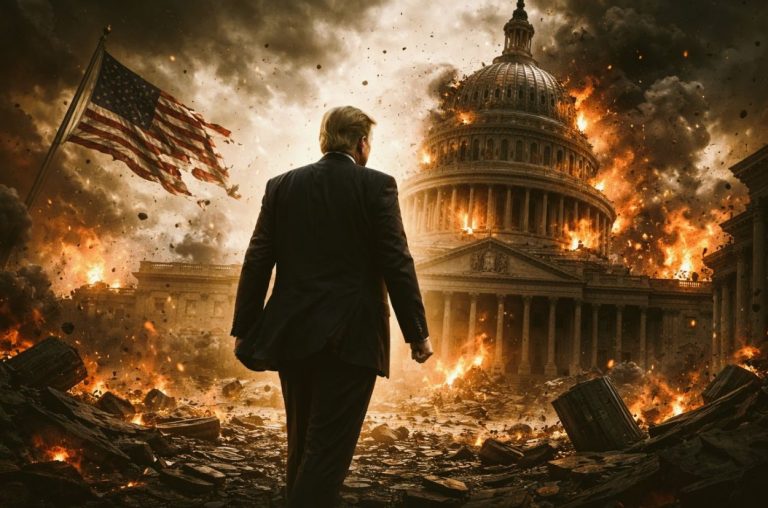

The alignment of sheriffs, militias, and veterans with Trump’s second-term agenda reveals the anatomy of authoritarian drift.

By Matthew A. McIntosh
Public Historian
Brewminate
Introduction
Sheriffs in Texas coordinating with federal immigration programs, self-styled militias rotating patrols along the border, and veterans volunteering to help carry out mass deportations: these are not isolated stories but fragments of a larger picture. In Donald Trump’s second term, the former president’s authoritarian ambitions are increasingly buttressed by sympathetic law enforcement officials, private militias, and hardline sheriffs positioning themselves as allies in what critics describe as a shadow army of “modern Blackshirts.” The convergence of official and unofficial enforcers signals a dangerous shift: a widening willingness to blur the line between state authority and paramilitary zeal, raising questions about how far these networks will go in advancing Trump’s agenda.
Historical and Conceptual Framing
To describe these converging forces as “fascist” is not rhetorical excess but a comparison with recognizable historical patterns. In the interwar years of Europe, leaders like Benito Mussolini and Adolf Hitler relied on paramilitary auxiliaries, Italy’s squadristi and Germany’s Brownshirts, to intimidate opponents, suppress dissent, and extend their authority beyond the formal state apparatus. Trump’s orbit of sheriffs, militias, and loyalists bears striking similarities to these movements, functioning as a “squadristi” of their own era, emboldened by presidential encouragement and hostile rhetoric toward political opponents.
Fascism historically thrives on this dual structure: the fusion of state power with informal, often violent street movements. The state provides legal cover and resources, while paramilitaries provide muscle, flexibility, and plausible deniability. In the United States, scholars and journalists alike have warned that this pattern is now visible. Sheriffs with expansive local powers, militias with histories of mobilization, and veterans trained in combat disciplines are aligning themselves rhetorically and operationally with Trump’s project.
Evidence of Alignment in Law Enforcement and Sheriffs
The sheriff’s badge, uniquely powerful in American law enforcement, has become one of the most visible symbols of Trump’s authoritarian project. Unlike police chiefs, who are appointed and subject to municipal oversight, sheriffs are elected officials who wield broad discretionary authority within their counties. That independence has made some of them ideal allies for Trump’s agenda, particularly on immigration enforcement.
Kinney County, Texas, Sheriff Brad Coe has openly worked to expand cooperation with Immigration and Customs Enforcement through the controversial 287(g) program, which deputizes local officers to enforce federal immigration law. Coe has also coordinated with like-minded sheriffs across Texas and Oklahoma, building a network of law enforcement actors ready to back Trump’s crackdown on migrants.
National associations of “constitutional sheriffs,” some of which embrace hardline views about federal power, have expressed enthusiastic support for Trump’s second-term agenda. These organizations frame their loyalty not to the Constitution in its broad interpretation, but to a selective reading that privileges executive power and conservative cultural norms. In doing so, they provide Trump with both political cover and operational capacity at the county level.
For observers, the concern is clear: when sheriffs, often the highest law enforcement authority in their jurisdictions, align themselves with a president pursuing authoritarian measures, the line between neutral law enforcement and partisan policing becomes dangerously blurred.
Militias and Paramilitary Actors: Recruitment, Collaboration, and Aspirations
Alongside sheriffs, civilian militias have surged back into prominence, emboldened by Trump’s second term and openly signaling their readiness to serve as force multipliers. These groups often claim to be “volunteers” defending the border or upholding constitutional rights, but their tactics echo the role of fascist street squads in history: intimidating opponents, patrolling communities, and creating a climate of fear.
Militias have already begun staging rotations to patrol the southern border, some coordinating with sympathetic landowners and local law enforcement. One such group, calling itself the “2nd American Militia,” announced plans for sustained patrols and even invoked violent rhetoric about confronting migrants and federal agents alike. Veterans and former law enforcement officers have swelled their ranks, providing military expertise and lending a veneer of legitimacy to organizations otherwise operating outside the law.
These groups blur the line between state-sanctioned enforcement and vigilante action. Militias have positioned themselves as auxiliaries, claiming to “fill the gap” left by federal agents. In practice, this often means targeting migrants or intimidating political opponents while wearing tactical gear and brandishing firearms. Their own language underscores the authoritarian drift: many see themselves as Trump’s loyal defenders, operating as his “street enforcers” in the way Mussolini’s squadristi or Hitler’s Brownshirts once did.
The Military and Veterans Vector
Perhaps the most unsettling development is the role of military veterans and, to a lesser extent, active-duty personnel in Trump’s second-term coalition. While the U.S. military as an institution maintains a formal commitment to political neutrality, the draw of Trump’s agenda has proven powerful among certain retired officers and enlisted members who view his leadership as aligned with their vision of national strength.
Veterans’ groups and former law enforcement officers have openly volunteered to assist in Trump’s deportation operations, pledging their skills for what they describe as a patriotic mission. Many of these individuals bring combat training, weapons proficiency, and organizational discipline, qualities that, when merged with civilian militias or local sheriffs’ departments, create a force that is both capable and difficult to monitor.
The overlap between veterans and militias has been visible for years, most starkly during the January 6 insurrection, when a significant share of those arrested were former military or police. That precedent looms over the present moment. Trump’s renewed empowerment, combined with his rhetoric about “my generals” and “real American warriors,” has amplified fears that loyalty to the man is supplanting loyalty to the Constitution.
Mechanisms of Control and Coercion
Trump’s second term has demonstrated how authoritarian ambitions are never realized through rhetoric alone; they depend on the construction of parallel enforcement systems that can exert pressure both legally and extralegally.
On the legal front, Trump has already shown a willingness to stretch emergency powers and deploy federal authority in ways that sideline oversight. His use of national emergency declarations at a pace unmatched by previous presidents, combined with deployments of the National Guard in U.S. cities, has underscored the executive’s capacity to blur the boundaries between law and political expedience. When local sheriffs pledge allegiance to these measures, they extend the federal reach into every county courthouse and jail.
The extralegal dimension is just as troubling. Militias operating in tactical gear, often armed and presenting themselves as quasi-law enforcement, create a climate of intimidation that is difficult to disentangle from official policing. Their presence at border zones or public protests amounts to a form of shadow policing. This mirrors the historical function of Blackshirts and Brownshirts: blurring legality by wrapping vigilante violence in the language of national salvation.
Layered over both is Trump’s rhetorical playbook. He frames political conflict as existential, dehumanizes opponents, and normalizes violence as an acceptable means of defense. Scholars warn this is the hallmark of authoritarian movements, the gradual erosion of guardrails not by abrupt coups, but by a steady normalization of coercion in everyday politics.
Counterarguments, Risks, and Limits
Not every law enforcement officer, sheriff, or veteran has aligned with Trump’s authoritarian project. The institutional culture of the U.S. military, in particular, has long emphasized loyalty to the Constitution over loyalty to any individual. Senior commanders and defense officials continue to assert that they will resist unlawful orders, and courts remain a significant counterweight to executive overreach.
Within law enforcement, the picture is similarly mixed. While hardline sheriffs have embraced Trump’s vision, others reject the politicization of their office and maintain traditional commitments to impartial policing. Civil society organizations, watchdog groups, and legal advocates have also mobilized to monitor abuses, file lawsuits, and shine light on the excesses of both state and paramilitary actors.
Scholars of authoritarianism stress that fascist projects are rarely linear. They often face resistance not only from the public but from within the state itself. DK Renton, writing in Spectre Journal, warns that authoritarian leaders frequently overreach, radicalizing too quickly and alienating moderates or institutional allies. Trump’s reliance on militias and loyal sheriffs could backfire if their excesses spark national outrage or trigger federal investigations.
There is also the resilience of American federalism. States and cities hostile to Trump’s agenda, particularly on immigration enforcement, continue to wield considerable power. Governors, legislatures, and local police chiefs retain the capacity to obstruct or blunt federal measures, creating friction that authoritarian projects cannot entirely overcome.
Current Examples and Developments
The outlines of this alignment are no longer theoretical; they are visible on the ground. In August 2025, Reuters reported on the Aryan Freedom Network, a neo-Nazi group that has gained momentum during Trump’s second term. Its rise underscores how white supremacist organizations are seizing the political moment, mobilizing recruits, and framing their activism as part of a broader struggle aligned with Trump’s nationalist rhetoric.
Meanwhile, sheriffs across the South and Midwest have stepped up cooperation with federal immigration enforcement. Militia activity has also accelerated. Their presence has already led to clashes with migrants and raised alarms among civil rights organizations.
At the same time, civil society pushback has intensified. Watchdog groups, journalists, and some state officials have begun documenting these developments, framing them as a direct threat to democracy. Investigations into militia recruitment networks and sheriff cooperation agreements are underway, though their effectiveness remains uncertain in the face of Trump’s consolidated executive power.
What to Watch: Forward Projection
If history teaches anything, it is that authoritarian projects do not announce their final form at the outset. They advance incrementally, testing the limits of institutions, civil society, and public tolerance. In Trump’s second term, several indicators will reveal whether the current convergence of sheriffs, militias, and veterans is evolving into something more systemic.
One sign is the degree of formal integration. If militias begin receiving tacit recognition, or even material support, from state or federal authorities, the distinction between vigilantes and law enforcement will collapse. Already, sheriff-led networks in Texas and Oklahoma provide a model for how such partnerships could scale nationally.
Another signal lies in urban deployments. Trump has already used the National Guard in major cities under the guise of restoring order (NPR). If similar forces, augmented by militia auxiliaries or sympathetic sheriffs, are turned on protests, the chilling effect on dissent could be profound.
Observers also warn of the normalization of “shadow policing.” When armed civilians patrol streets or borders under the banner of protecting “real Americans,” the threshold for state-sanctioned violence lowers. This would mark a decisive step toward authoritarian consolidation, one in which coercion becomes a routine feature of political life.
Finally, there is the danger of overreach. As Spectre Journal notes, authoritarian movements can radicalize too quickly, alienating allies and provoking backlash. Should militias escalate violence, or sheriffs cross obvious constitutional lines, the resulting lawsuits and public outcry could either restrain or accelerate Trump’s reliance on extralegal power.
Conclusion
The alignment of sheriffs, militias, and veterans with Trump’s second-term agenda reveals the anatomy of authoritarian drift: a fusion of state authority with extralegals, where the badge and the rifle converge in service of a leader rather than a Constitution. The historical echoes are stark. Mussolini’s squadristi and Hitler’s Brownshirts were not born as state armies; they began as parallel forces whose loyalty to a man blurred the boundary between governance and vigilantism.
Today, Trump presides over a similar dynamic. Sheriffs deputized to enforce federal immigration law, militias patrolling the border, and veterans offering their combat experience collectively constitute a shadow army that extends his reach beyond Washington.
The counterforces (courts, civil society, dissenting officials) remain potent but embattled. Their effectiveness will depend on whether Americans recognize the stakes before coercion becomes normalized. Fascism rarely arrives overnight; it advances step by step, through the steady erosion of boundaries and the accommodation of violence dressed in patriotic language.
In this moment, the question is not whether Trump aspires to authoritarian control; his actions and rhetoric make that clear. The question is how far these newly empowered enforcers, both official and unofficial, are willing to go to secure it, and how firmly the rest of the nation is prepared to resist.
Originally published by Brewminate, 09.29.2025, under the terms of a Creative Commons Attribution-NonCommercial-NoDerivatives 4.0 International license.


